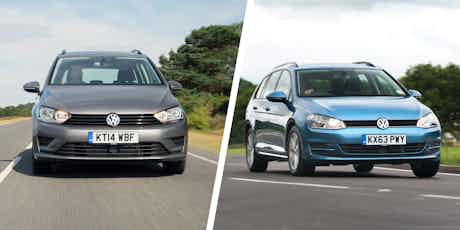Volkswagen Golf SV vs Golf Estate: practical family cars compared
May 05, 2015 by carwow staff

Estate or MPV (multi-purpose vehicle)? It’s a common question – and one you’ve likely asked yourself if you’re hunting for a new family car. With adults, kids and pets to think about, either is often a better choice than regular hatchback.
Volkswagen plays in both markets, leading the pack with the Golf Estate and and Golf SV. The former adds a larger boot to the regular Golf, while the latter majors on cabin space.
The question is, which option makes the most sense? Here’s where we’ll find out…

Styling
Beauty is subjective, but we’re convinced the Golf estate wins this round hands down. The regular Golf hatchback is inoffensively handsome, and the Estate offers the same crisp lines and smart proportions on a body stretched by 31cm.
The SV looks like someone’s taken a regular Golf and inflated it. It’s by no means ugly – and that taller body has its benefits, which we’ll come to – but it isn’t a car that you’ll lust after. Nonetheless, minor details like the headlamp units and door mirrors single out the Golf SV out as a high quality product.

Interior
If you’ve driven a regular Golf you’ll feel right at home in the estate: the two look identical from the driving seat.
That’s no bad thing, because the Golf’s cabin is well-screwed together and features an assortment of plastics which all feel expensive and soft to the touch. Cabin space is almost exactly what you’d find in the hatchback, too, so four adults will fit themselves inside with no problems.
The place where that longer body is of most benefit is the boot. At 605 litres, it’s one of the largest of its type, and benefits from a wide door and low loading lip.
Boot space is a strong point of the Golf SV, too. It’s slightly smaller – 590-litres – but the rear bench moves, either to improve rear leg room or aid in carrying larger items. It can also recline, so it’s easy for those in the back to get comfortable.
At this point we’re willing to forgive it some it its styling compromises. Being both taller and wider than the estate, there’s plenty of space inside – more, even, than its closest rival, the Ford C-Max. The higher seating position might aid in fitting rear child seats, which secure using one of two Isofix mounting points in both the SV and the Estate.
The SV also benefits from one or two extra storage spaces, which are the perfect spots for kids to hide old crisp packets that then go unnoticed for months.

Engines
Many of the same engines are found in both the Estate and the SV. Each kicks off with an 85hp 1.2-litre turbo petrol, and features variants of a 1.4 turbo petrol and 1.6 and 2.0-litre diesels.
The stars of each range are the 110hp 1.6-litre diesel and a 1.4-litre turbo. Expect great performance and 70mpg-plus fuel economy from the former; the latter is a smooth, refined, economical choice.
Each SV weighs around 30 kilos more than the equivalent estate, so performance and economy are slightly blunted – but not enough that it should put you off.
If you’re after a performance model, there’s only one way to go. The most powerful version of the SV ‘only’ produces 150hp, but opt for the Golf Estate and it opens up the excellent GTD and stonking Golf R variants.
The GTD is powered by a 184hp 2.0-litre turbo diesel, which goes from standing to 62mph in 7.9 seconds. The Golf R makes use of 300hp and four-wheel drive to cover the same sprint in only 5.1 seconds.
Both cars make a strong case for being the best all-rounders that money can buy with their blend of performance, quality and space

Driving
Both cars share common underpinnings (as do the Skoda Octavia and Audi TT Roadster), so the driving experience is similar.
Testers believe that the SV feels almost as agile as a regular Golf hatchback. The slight weight penalty and raised centre of gravity are said to only make themselves felt when engaging in the sort of hooliganism for which practical family cars aren’t designed. Aside from the slightly warmed-over GT model, the ride is comfortable, while wind and road noise are well-suppressed. The same is true of the Estate.
It’s worth noting that although it’s taller and wider, the SV is about 22cm shorter than the Estate, so you may find it easier to park in tight spaces.

Value for money
Equipment levels are the same at each level within the range – even down to the design of the alloy wheels – but you’ll pay a £1,105 premium for the Golf SV’s extra space.
The SV’s insurance is also higher than the Estate by a group or two for each model. Nonetheless, both are very safe, achieving the maximum five-star rating in Euro NCAP crash tests.

Verdict
Given that the pair are so similar to drive, you have to ask how the SV justifies the extra price over the Estate. There’s the sliding rear bench and the extra passenger and storage space, but that’s about it. If you can justify the extra money for those one or two perks, then the Golf SV would make for a safe, spacious and sensible family car.
However, the Estate will do almost everything the SV can – some of it slightly better – all while costing less in the first place. So, perhaps not surprisingly, it’s the estate that we’d go for.
What next?
Head over to our car configurator to see how much carwow’s network of approved Volkswagen dealers could save you on a Golf SV or a Golf Estate. For more options, head over to our car deals page to see our latest discounts.















